Several months ago, while I was in the middle of a Swimming Pool Equipment Pad renovation and rebuild, I became aware of just how much water my pool was losing on a daily basis (yes it was summer in the desert and I have a fairly large pool surface area).
At first I thought I might have a leak somewhere. In typical fashion, as I do now whenever I have a question or concern regarding my swimming pool, I did my research on TFP and reached out to the members here for their advice and thoughts.
This quest led to some insightful and informative discussions regarding water loss, evaporation rates, “bucket tests”, measuring the water loss and then on to the use of water meters to measure that loss. I really appreciate all of the input that I received from the members here.
For a little background, the two threads that really got me started down this path are listed below (I’m going to provide a link to this thread over on these two threads to give further relevance to them, as this is somewhat of a continuation to both).
Water Loss (9/25/18)
Flow Meter – Anyone use them (4/28/18)
So, in my research with several water meter companies, I discovered that most water meters out there (except ones that cost thousands of dollars) do not measure water flow rates below about .25 gallons (4 cups) per minute. That was a problem for me, as my SP Auto-fill Leveler runs constantly and mostly just drips water. I wanted to be able to accurately measure just how much water I used each and every month throughout the year. Especially since I am now using soft water for evaporation and backwash compensation.
Over about two months and lots of research, I believe that I have found the solution that works best for me. I did some re-plumbing, purchased the equipment, installed and calibrated. Photos are provided below.
I used a Clark Solutions PFA Turbine Flow Sensor and a Precision Digital ProVu Pulse Input Flow Rate/Totalizer. The way it works it that a static worm in the sensor forces the passing water to spin. The spinning fluid drives a rotor with reflectors into a friction-less rotation. A high resolution infrared sensor determines the rate of flow by counting the passing reflections. This information (pulses) is transmitted to the digital display where it is interpreted and displayed in a highly accurate digital format.
Note that I plumbed this in such a way, that I can now choose to use either city water or soft water by the manipulation of two ball valves.
I think I am done with this project for now (hmmm, what to do now? ) It’s working great and giving me some very accurate readings. The only thing, is that the flow rate/totalizer is calibrated in liters for more accuracy, but that’s not hard to convert to gallons.
) It’s working great and giving me some very accurate readings. The only thing, is that the flow rate/totalizer is calibrated in liters for more accuracy, but that’s not hard to convert to gallons.
The meter itself is plumbed in by my wife’s rose garden (she sure is happy now that I have put everything back to the way it was and gotten away from her roses ). There is a direct burial cable that runs about 25 feet over to the pool equipment pad. I used IMC conduit to get the cable into the low voltage raceway of the load center, then through my low voltage junction box and then to the flow rate/totalizer enclosure. Power for the totalizer (220 Vac) is provided through the load center system transformer circuit breaker. Since my Lutron smart switch for the pool light was in the way of where I wanted to mount the totalizer enclosure, I chose to just go ahead and install it in the flow rate/totalizer enclosure. That worked out pretty good.
). There is a direct burial cable that runs about 25 feet over to the pool equipment pad. I used IMC conduit to get the cable into the low voltage raceway of the load center, then through my low voltage junction box and then to the flow rate/totalizer enclosure. Power for the totalizer (220 Vac) is provided through the load center system transformer circuit breaker. Since my Lutron smart switch for the pool light was in the way of where I wanted to mount the totalizer enclosure, I chose to just go ahead and install it in the flow rate/totalizer enclosure. That worked out pretty good.
So anyway, I believe that I have resolved this issue for my application. I'm looking forward to measuring monthly water usage throughout the upcoming year and graphing it out. I'll update this thread with the results as the year progresses. Anyone living in the desert, with about the same surface area as my pool, can use my results to get a good idea of their own monthly water usage.
r..
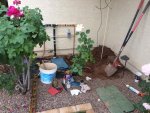
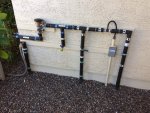
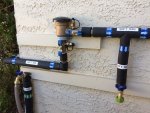
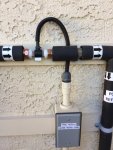
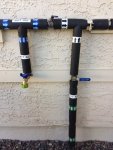
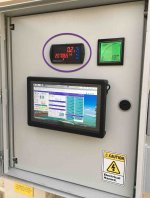
At first I thought I might have a leak somewhere. In typical fashion, as I do now whenever I have a question or concern regarding my swimming pool, I did my research on TFP and reached out to the members here for their advice and thoughts.
This quest led to some insightful and informative discussions regarding water loss, evaporation rates, “bucket tests”, measuring the water loss and then on to the use of water meters to measure that loss. I really appreciate all of the input that I received from the members here.
For a little background, the two threads that really got me started down this path are listed below (I’m going to provide a link to this thread over on these two threads to give further relevance to them, as this is somewhat of a continuation to both).
Water Loss (9/25/18)
Flow Meter – Anyone use them (4/28/18)
So, in my research with several water meter companies, I discovered that most water meters out there (except ones that cost thousands of dollars) do not measure water flow rates below about .25 gallons (4 cups) per minute. That was a problem for me, as my SP Auto-fill Leveler runs constantly and mostly just drips water. I wanted to be able to accurately measure just how much water I used each and every month throughout the year. Especially since I am now using soft water for evaporation and backwash compensation.
Over about two months and lots of research, I believe that I have found the solution that works best for me. I did some re-plumbing, purchased the equipment, installed and calibrated. Photos are provided below.
I used a Clark Solutions PFA Turbine Flow Sensor and a Precision Digital ProVu Pulse Input Flow Rate/Totalizer. The way it works it that a static worm in the sensor forces the passing water to spin. The spinning fluid drives a rotor with reflectors into a friction-less rotation. A high resolution infrared sensor determines the rate of flow by counting the passing reflections. This information (pulses) is transmitted to the digital display where it is interpreted and displayed in a highly accurate digital format.
Note that I plumbed this in such a way, that I can now choose to use either city water or soft water by the manipulation of two ball valves.
I think I am done with this project for now (hmmm, what to do now?
The meter itself is plumbed in by my wife’s rose garden (she sure is happy now that I have put everything back to the way it was and gotten away from her roses
So anyway, I believe that I have resolved this issue for my application. I'm looking forward to measuring monthly water usage throughout the upcoming year and graphing it out. I'll update this thread with the results as the year progresses. Anyone living in the desert, with about the same surface area as my pool, can use my results to get a good idea of their own monthly water usage.
r..






Last edited:

